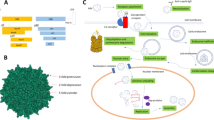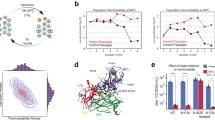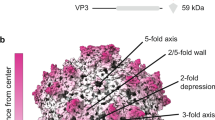Abstract
Virus families have evolved different strategies for genome uncoating, which are also followed by recombinant vectors. Vectors derived from adeno-associated viruses (AAV) are considered as leading delivery tools for in vivo gene transfer, and in particular gene therapy. Using a combination of atomic force microscopy (AFM), biochemical experiments, and physical modeling, we investigated here the physical properties and stability of AAV vector particles. We first compared the morphological properties of AAV vectors derived from two different serotypes (AAV8 and AAV9). Furthermore, we triggered ssDNA uncoating by incubating vector particles to increasing controlled temperatures. Our analyses, performed at the single-particle level, indicate that genome release can occur in vitro via two alternative pathways: either the capsid remains intact and ejects linearly the ssDNA molecule, or the capsid is ruptured, leaving ssDNA in a compact entangled conformation. The analysis of the length distributions of ejected genomes further revealed a two-step ejection behavior. We propose a kinetic model aimed at quantitatively describing the evolution of capsids and genomes along the different pathways, as a function of time and temperature. This model allows quantifying the relative stability of AAV8 and AAV9 particles.






Similar content being viewed by others
References
Mingozzi, F., High, K.A.: Therapeutic in vivo gene transfer for genetic disease using AAV: progress and challenges. Nat. Rev. Genet. 12(5), 341–355 (2011). https://doi.org/10.1038/nrg2988
Asokan, A., Schaffer, D.V., Samulski, R.J.: The AAV vector toolkit: poised at the clinical crossroads. Mol. Ther. : J. Am. Soc. Gene Ther. 20(4), 699–708 (2012). https://doi.org/10.1038/mt.2011.287
Buning, H., Huber, A., Zhang, L., Meumann, N., Hacker, U.: Engineering the AAV capsid to optimize vector–host interactions. Curr. Opin. Pharmacol. 24, 94–104 (2015). https://doi.org/10.1016/j.coph.2015.08.002
Nonnenmacher, M., Weber, T.: Intracellular transport of recombinant adeno-associated virus vectors. Gene Ther. 19(6), 649–658 (2012). https://doi.org/10.1038/gt.2012.6
Hauck, B., Zhao, W., High, C., Xiao, W.: Intracellular processing, not single-stranded DNA accumulation, is crucial for recombinant adeno-associated virus transduction. J. Virol. 78, 13678–13686 (2004)
Thomas, C.E., Storm, T.A., Huang, Z., Kay, M.A.: Rapid uncoating of vector genomes is the key to efficient liver transduction with pseudotyped adeno-associated virus vectors. J. Virol. 78(6), 3110–3122 (2004)
Bennett, A., Patel, S., Mietzsch, M., Jose, A., Lins-Austin, B., Yu, J.C., Bothner, B., McKenna, R., Agbandje-McKenna, M.: Thermal stability as a determinant of AAV serotype identity. Mol. Ther. Methods Clin. Dev. 6, 171–182 (2017). https://doi.org/10.1016/j.omtm.2017.07.003
Horowitz, E.D., Rahman, K.S., Bower, B.D., Dismuke, D.J., Falvo, M.R., Griffith, J.D., Harvey, S.C., Asokan, A.: Biophysical and ultrastructural characterization of adeno-associated virus capsid uncoating and genome release. J. Virol. 87(6), 2994–3002 (2013). https://doi.org/10.1128/JVI.03017-12
Rayaprolu, V., Kruse, S., Kant, R., Venkatakrishnan, B., Movahed, N., Brooke, D., Lins, B., Bennett, A., Potter, T., McKenna, R., Agbandje-McKenna, M., Bothner, B.: Comparative analysis of adeno-associated virus capsid stability and dynamics. J. Virol. 87(24), 13150–13160 (2013). https://doi.org/10.1128/JVI.01415-13
Venkatakrishnan, B., Yarbrough, J., Domsic, J., Bennett, A., Bothner, B., Kozyreva, O.G., Samulski, R.J., Muzyczka, N., McKenna, R., Agbandje-McKenna, M.: Structure and dynamics of adeno-associated virus serotype 1 VP1-unique N-terminal domain and its role in capsid trafficking. J. Virol. 87(9), 4974–4984 (2013). https://doi.org/10.1128/JVI.02524-12
Zeng, C., Moller-Tank, S., Asokan, A., Dragnea, B.: Probing the link among genomic cargo, contact mechanics, and Nanoindentation in recombinant adeno-associated virus 2. J. Phys. Chem. B 121(8), 1843–1853 (2017a). https://doi.org/10.1021/acs.jpcb.6b10131
Van Kampen, N.G.: Stochastic processes in physics and chemistry, 3rd edition. North-Holland (2007)
Salvetti, A., Oreve, S., Chadeuf, G., Favre, D., Cherel, Y., Champion-Arnaud, P., David-Ameline, J., Moullier, P.: Factors influencing recombinant adeno-associated virus production. Hum. Gene Ther. 9(5), 695–706 (1998). https://doi.org/10.1089/hum.1998.9.5-695
Xiao, X., Li, J., Samulski, R.J.: Production of high-titer recombinant adeno-associated virus vectors in the absence of helper adenovirus. J. Virol. 72(3), 2224–2232 (1998)
Wobus, C.E., Hugle-Dorr, B., Girod, A., Petersen, G., Hallek, M., Kleinschmidt, J.A.: Monoclonal antibodies against the adeno-associated virus type 2 (AAV-2) capsid: epitope mapping and identification of capsid domains involved in AAV-2-cell interaction and neutralization of AAV-2 infection. J. Virol. 74(19), 9281–9293 (2000)
Faivre-Moskalenko, C., Bernaud, J., Thomas, A., Tartour, K., Beck, Y., Iazykov, M., Danial, J., Lourdin, M., Muriaux, D., Castelnovo, M.: RNA control of HIV-1 particle size polydispersity. PLoS One 9(1), e83874 (2014). https://doi.org/10.1371/journal.pone.0083874
Komura, S., Tamura, K., Kato, T.: Buckling of spherical shells adhering onto a rigid substrate. Eur. Phys. J. E. Soft Matter 18(3), 343–358 (2005). https://doi.org/10.1140/epje/e2005-00038-5
Zeng, C., Hernando-Perez, M., Dragnea, B., Ma, X., van der Schoot, P., Zandi, R.: Contact mechanics of a small icosahedral virus. Phys. Rev. Lett. 119(3), 038102 (2017b)
Bleker, S., Sonntag, F., Kleinschmidt, J.A.: Mutational analysis of narrow pores at the fivefold symmetry axes of adeno-associated virus type 2 capsids reveals a dual role in genome packaging and activation of phospholipase A2 activity. J. Virol. 79(4), 2528–2540 (2005). https://doi.org/10.1128/JVI.79.4.2528-2540.2005
Kronenberg, S., Bottcher, B., von der Lieth, C.W., Bleker, S., Kleinschmidt, J.A.: A conformational change in the adeno-associated virus type 2 capsid leads to the exposure of hidden VP1 N termini. J. Virol. 79(9), 5296–5303 (2005). https://doi.org/10.1128/JVI.79.9.5296-5303.2005
Ros, C., Baltzer, C., Mani, B., Kempf, C.: Parvovirus uncoating in vitro reveals a mechanism of DNA release without capsid disassembly and striking differences in encapsidated DNA stability. Virology 345(1), 137–147 (2006). https://doi.org/10.1016/j.virol.2005.09.030
Luque, A., Zandi, R., Reguera, D.: Optimal architectures of elongated viruses. Proc. Natl. Acad. Sci. U. S. A. 107(12), 5323–5328 (2010). https://doi.org/10.1073/pnas.0915122107
Reddy, V.S., Giesing, H.A., Morton, R.T., Kumar, A., Post, C.B., Brooks 3rd, C.L., Johnson, J.E.: Energetics of quasiequivalence: computational analysis of protein–protein interactions in icosahedral viruses. Biophys. J. 74(1), 546–558 (1998). https://doi.org/10.1016/S0006-3495(98)77813-0
Zandi, R., Reguera, D.: Mechanical properties of viral capsids. Phys. Rev. E Stat. Nonlinear Soft Matter Phys. 72(2 Pt 1), 021917 (2005). https://doi.org/10.1103/PhysRevE.72.021917
Muthukumar, M.: Polymer escape through a nanopore. J. Chem. Phys. 118, 5174 (2003)
Acknowledgments
We would like to thank Federico Mingozzi for helpful discussions. This work was supported by Institut National de la Santé et de la Recherche Médicale (INSERM), Centre National de la Recherche Scientifique (CNRS; PEPS MPI). It was also funded by grants from the Ecole Normale Supérieure (ENS) de Lyon (to CFM and AS) and Association Française contre les Myopathies (AFM) to AS, HB, and CFM.
Authors’ contributions statement
JB, AR, AS, and CFM conceived and designed the experiments. JB, AF, AR, LG, and AL performed the experiments. JB, AF, AR, MC, HB, AS, and CFM analyzed the data. MC, AS, CFM wrote the paper. .
Funding
The authors declare no competing financial interests.
Author information
Authors and Affiliations
Corresponding authors
Ethics declarations
Conflict of interest
The authors declare that they have no conflict of interest.
Electronic supplementary material
ESM 1
Supplemental Figure 1 Protocol for the analysis of the AAV response to changes in temperature. Heating of AAV capsids is done for a fixed time at various temperatures ranging from RT to 80 °C before quenching on ice. Mg2+ ions are necessary for DNA binding onto mica, they are added after the heating process as divalent ions are expected to have an effect on capsid stability. The solution is incubated for 5 min on the mica to favor electrostatic adsorption of both DNA and AAV virions. Supplemental Fig. 2: AFM topographic image of AAV8 particles and automated image analysis. (a) raw AFM topographic image of AAV8 capsids, (b) binary image resulting from height and area thresholding, and (c) final topographic image after a few more steps including fractal parameter selection. The further measure of diameter, height or asymmetry on several hundreds of capsids analyzed one by one provides a quantitative morphological characterization of AAV. Supplemental Fig. 3: Automated image analysis of the DNA molecules ejected from the destabilized virions. Using a home-made Matlab script, we can remove the capsids from the image (height thresholding) and skeletonize the DNA fragments in order to measure their length distribution as a function of temperature. Each image with its number corresponds to a different step in the analysis procedure. (a) Initial AFM topographic image. (b) The capsids are removed by applying a height threshold that keep only pixels below 2 nm. (c) Image obtained after the virion has been removed and following by erosion of 1 to 2 pixels around the holes created by capsid removal (height color has been changed). (d) Binary image of DNA only obtained by applying a noise threshold (0.2 nm). (e) The skeleton of DNA filaments can be extracted from the binary image by using morphological tools (erosion). (f) Final topographic image corresponds to image in (c) where the DNA skeleton path has been overlapped in red, as it can clearly been distinguished in the image zoom. Supplemental Fig. 4: AFM imaging of AAV9 virion destabilization induced by heating. Typical AFM images for different heating conditions (a) T = 50 °C, (b) T = 60 °C, (c) T = 65 °C, (d) T = 70 °C, (e) T = 75 °C and (f) T = 80 °C. Each image is shown twice: on the right a color scale of 25 nm is used to see the viral capsids, on the left a 5 nm color scale is chosen to explore what is happening near the surface (ss-DNA width is below 1 nm). At T = 50 °C (a) opened capsids are already observed as DNA is visible on the surface. By increasing the temperature (b), (c) and (d), some filaments can still be observed around the capsids. At higher temperatures (e), both free DNA and DNA linked to capsids exist. At 80 °C mostly free DNA is detected on the surface (f). (PDF 5983 kb)
Rights and permissions
About this article
Cite this article
Bernaud, J., Rossi, A., Fis, A. et al. Characterization of AAV vector particle stability at the single-capsid level. J Biol Phys 44, 181–194 (2018). https://doi.org/10.1007/s10867-018-9488-5
Received:
Accepted:
Published:
Issue Date:
DOI: https://doi.org/10.1007/s10867-018-9488-5




